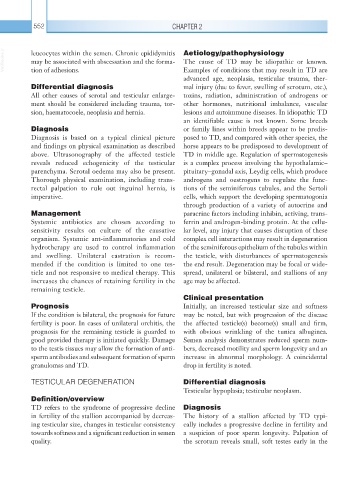Page 577 - Equine Clinical Medicine, Surgery and Reproduction, 2nd Edition
P. 577
552 CHAPTER 2
VetBooks.ir leucocytes within the semen. Chronic epididymitis Aetiology/pathophysiology
The cause of TD may be idiopathic or known.
may be associated with abscessation and the forma-
Examples of conditions that may result in TD are
tion of adhesions.
advanced age, neoplasia, testicular trauma, ther-
Differential diagnosis mal injury (due to fever, swelling of scrotum, etc.),
All other causes of scrotal and testicular enlarge- toxins, radiation, administration of androgens or
ment should be considered including trauma, tor- other hormones, nutritional imbalance, vascular
sion, haematocoele, neoplasia and hernia. lesions and autoimmune diseases. In idiopathic TD
an identifiable cause is not known. Some breeds
Diagnosis or family lines within breeds appear to be predis-
Diagnosis is based on a typical clinical picture posed to TD, and compared with other species, the
and findings on physical examination as described horse appears to be predisposed to development of
above. Ultrasonography of the affected testicle TD in middle age. Regulation of spermatogenesis
reveals reduced echogenicity of the testicular is a complex process involving the hypothalamic–
parenchyma. Scrotal oedema may also be present. pituitary–gonadal axis, Leydig cells, which produce
Thorough physical examination, including trans- androgens and oestrogens to regulate the func-
rectal palpation to rule out inguinal hernia, is tions of the seminiferous tubules, and the Sertoli
imperative. cells, which support the developing spermatogonia
through production of a variety of autocrine and
Management paracrine factors including inhibin, activing, trans-
Systemic antibiotics are chosen according to ferrin and androgen-binding protein. At the cellu-
sensitivity results on culture of the causative lar level, any injury that causes disruption of these
organism. Systemic ant-inflammatories and cold complex cell interactions may result in degeneration
hydrotherapy are used to control inflammation of the seminiferous epithelium of the tubules within
and swelling. Unilateral castration is recom- the testicle, with disturbances of spermatogenesis
mended if the condition is limited to one tes- the end result. Degeneration may be focal or wide-
ticle and not responsive to medical therapy. This spread, unilateral or bilateral, and stallions of any
increases the chances of retaining fertility in the age may be affected.
remaining testicle.
Clinical presentation
Prognosis Initially, an increased testicular size and softness
If the condition is bilateral, the prognosis for future may be noted, but with progression of the disease
fertility is poor. In cases of unilateral orchitis, the the affected testicle(s) become(s) small and firm,
prognosis for the remaining testicle is guarded to with obvious wrinkling of the tunica albuginea.
good provided therapy is initiated quickly. Damage Semen analysis demonstrates reduced sperm num-
to the testis tissues may allow the formation of anti- bers, decreased motility and sperm longevity and an
sperm antibodies and subsequent formation of sperm increase in abnormal morphology. A coincidental
granulomas and TD. drop in fertility is noted.
TESTICULAR DEGENERATION Differential diagnosis
Testicular hypoplasia; testicular neoplasm.
Definition/overview
TD refers to the syndrome of progressive decline Diagnosis
in fertility of the stallion accompanied by decreas- The history of a stallion affected by TD typi-
ing testicular size, changes in testicular consistency cally includes a progressive decline in fertility and
towards softness and a significant reduction in semen a suspicion of poor sperm longevity. Palpation of
quality. the scrotum reveals small, soft testes early in the

